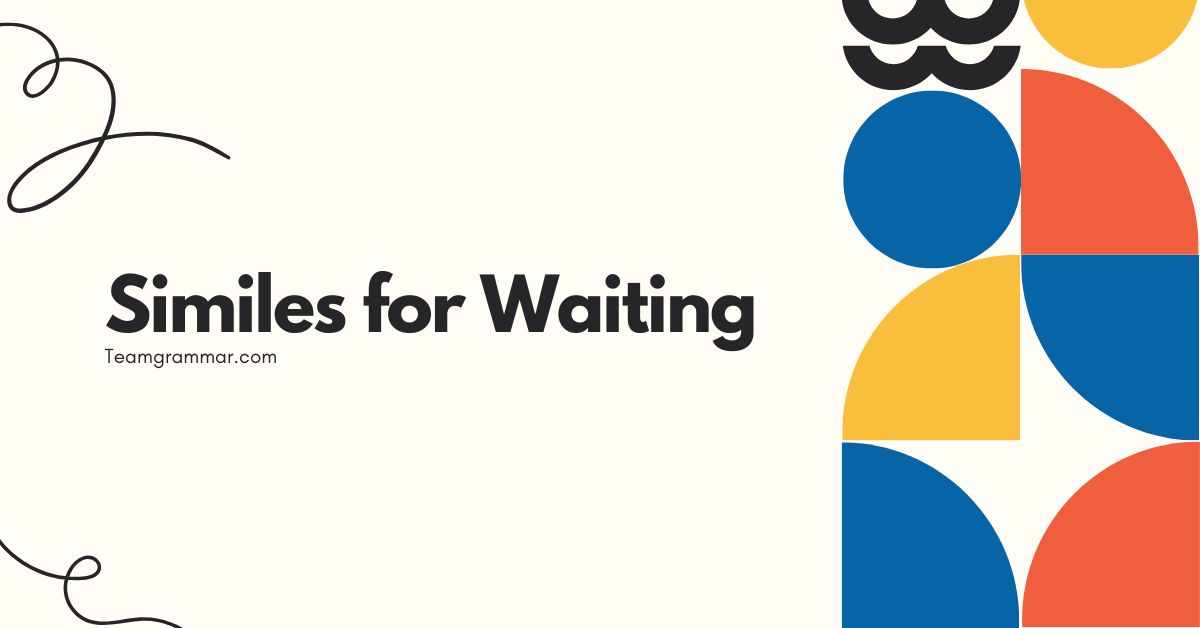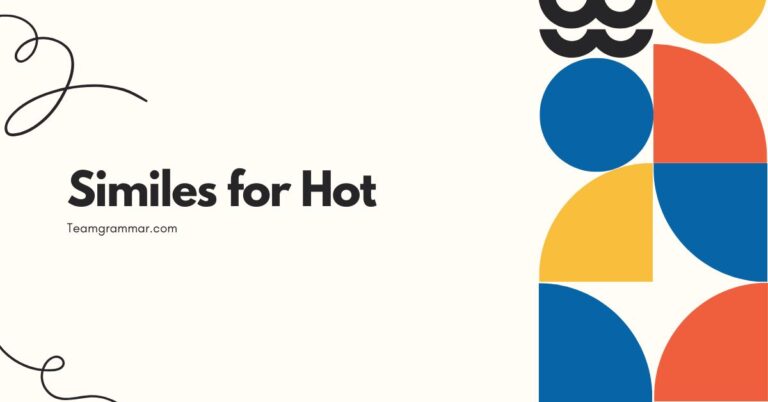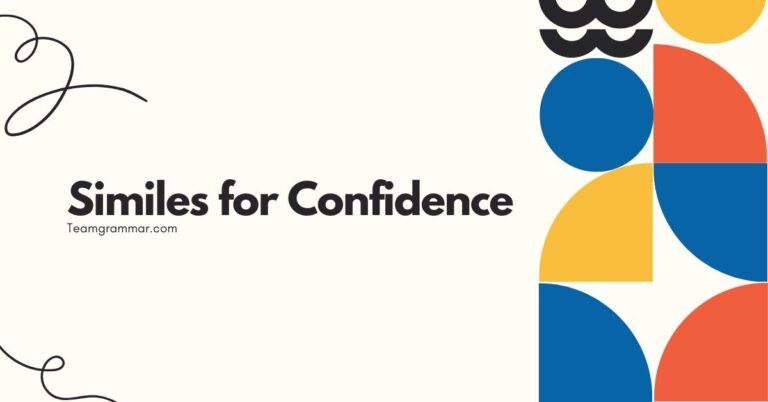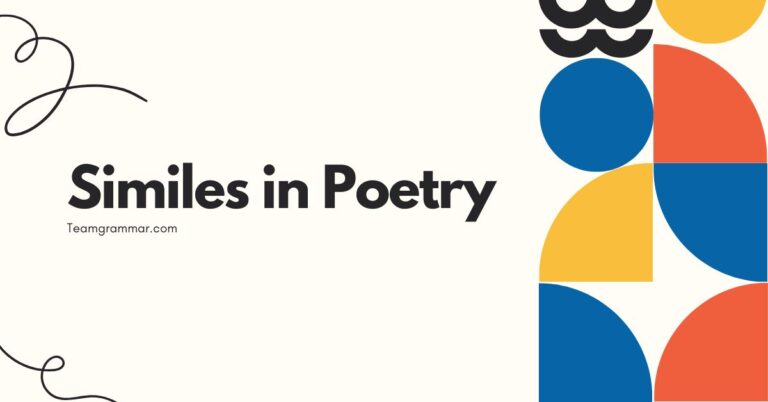31 Similes for Waiting: A Comprehensive Guide
Waiting is a universal experience, often filled with anticipation, frustration, or boredom. Similes, with their ability to create vivid comparisons, offer a powerful tool to express the nuances of waiting.
Mastering similes for waiting enhances your descriptive writing, making it more engaging and relatable. This guide is crafted for students, writers, and English language learners who wish to enrich their vocabulary and improve their ability to convey the feeling of waiting effectively.
By understanding the structure, types, and usage of similes in this context, you can elevate your communication skills and add depth to your narratives.
Table of Contents
- Definition of Similes for Waiting
- Structural Breakdown of Similes
- Types of Similes for Waiting
- Examples of Similes for Waiting
- Usage Rules for Similes
- Common Mistakes with Similes
- Practice Exercises
- Advanced Topics in Similes
- Frequently Asked Questions
- Conclusion
Definition of Similes for Waiting
Asimileis a figure of speech that compares two different things, using the words “like” or “as.” Similes are used to create a vivid image or to emphasize a particular quality. In the context of waiting, similes help to express how long, tedious, or emotionally charged the experience feels.
They provide a way to connect the abstract concept of waiting to something more concrete and relatable.
The primary function of similes in describing waiting is to enhance the reader’s understanding of the emotional and psychological state of the person waiting. By drawing comparisons to familiar experiences or objects, similes can convey the intensity of anticipation, the frustration of delay, or the dullness of boredom.
Similes also add color and creativity to writing, making it more engaging and memorable. Understanding the function of a simile allows for more effective communication of the experience of waiting.
Similes related to waiting can be classified based on what aspect of waiting they emphasize: duration, emotional state, or physical sensation. For example, a simile might describe waiting as “slow as molasses” (duration), “anxious as a student awaiting exam results” (emotional state), or “stiff as a board” (physical sensation).
The context in which the simile is used greatly influences its impact. A simile used in a suspenseful narrative will have a different effect than one used in a humorous anecdote.
Consider the context to maximize the effectiveness of your writing.
Structural Breakdown of Similes
Similes follow a basic structure:A is like/as B. “A” is the subject being described (in this case, waiting), and “B” is the object or concept to which it is being compared.
The words “like” or “as” are the connectors that establish the comparison. Understanding this structure is essential for creating effective and grammatically correct similes.
The key components of a simile are the subject, the connecting word (“like” or “as”), and the object of comparison. The subject is the element being described, the connecting word forms the comparison, and the object of comparison provides the basis for the comparison.
For instance, in the simile “waiting is like watching paint dry,” “waiting” is the subject, “like” is the connecting word, and “watching paint dry” is the object of comparison. The effectiveness of a simile relies on the relationship between the subject and the object of comparison.
The power of a simile lies in the connection between the two seemingly unrelated things. The more unexpected yet relevant the comparison, the more effective the simile.
For example, comparing waiting to “watching grass grow” evokes a sense of extreme slowness and boredom. The comparison should be clear enough for the reader to understand the intended meaning, but also creative enough to leave a lasting impression.
A well-crafted simile can transform a simple description into a vivid and memorable image, enriching the reader’s experience.
Types of Similes for Waiting
Similes for waiting can be categorized based on the aspect of waiting they emphasize. These categories include similes that focus on the duration of waiting, the emotional state during waiting, and the physical sensations experienced while waiting.
Understanding these categories can help you choose the most effective simile to convey your intended meaning.
Similes Emphasizing Duration
These similes highlight how long the waiting period feels. They often use comparisons to things known for their slowness or tediousness.
Similes Emphasizing Emotional State
These similes focus on the feelings associated with waiting, such as anxiety, boredom, anticipation, or frustration. They often compare the emotional experience to situations that evoke similar feelings.
Similes Emphasizing Physical Sensations
These similes describe the physical feelings that can accompany waiting, such as restlessness, stiffness, or tension. They often compare the physical state to objects or situations that create similar sensations.
Examples of Similes for Waiting
Here are several examples of similes for waiting, categorized by the aspect of waiting they emphasize. These examples are designed to illustrate the different ways similes can be used to describe the experience of waiting.
Duration-Focused Similes
The following table provides examples of similes that emphasize the length or slowness of waiting. Each simile draws a comparison to something known for its extended duration or lack of progress.
| Simile | Explanation |
|---|---|
| Waiting is like watching paint dry. | Emphasizes the extreme slowness and boredom of waiting. |
| Waiting is as slow as molasses in January. | Highlights the sluggish pace of waiting, especially when time seems to drag. |
| Waiting felt like an eternity. | Conveys the sense that time is passing very slowly. |
| Waiting is like watching grass grow. | Similar to watching paint dry, it suggests a monotonous and slow process. |
| The wait was as long as a presidential campaign. | Compares the duration to a lengthy and drawn-out event. |
| Waiting is like counting grains of sand. | Illustrates the tedious and seemingly endless nature of waiting. |
| Waiting is as drawn out as a Shakespearean play. | References the length and complexity of Shakespearean plays. |
| Waiting stretched on like a rubber band. | Suggests the feeling of time being prolonged and stretched thin. |
| Waiting is like a traffic jam on a Friday evening. | Captures the frustration and slowness of being stuck. |
| Waiting is like a year without summer. | Implies a significant and unwelcome delay. |
| Waiting is as painful as a root canal. | Highlights the unpleasant and drawn-out nature of the experience. |
| Waiting is like untangling Christmas lights. | Emphasizes the tedious and frustrating nature of a prolonged task. |
| Waiting felt like wading through mud. | Suggests a slow and difficult progression. |
| Waiting is similar to watching a glacier move. | Implies an almost imperceptible rate of progress. |
| The wait was as endless as the night sky. | Conveys a sense of vastness and unending duration. |
| Waiting is like reading a book with missing pages. | Emphasizes the incompleteness and frustration of the process. |
| Waiting is as tiring as running a marathon. | Highlights the mental and emotional exhaustion of prolonged waiting. |
| Waiting is like being stuck in quicksand. | Suggests a feeling of being trapped and unable to move forward. |
| Waiting is as dull as a cloudy day. | Emphasizes the lack of excitement or stimulation during the wait. |
| Waiting is like watching a kettle boil. | Captures the slow and seemingly uneventful progression of time. |
| Waiting is comparable to a slow internet connection. | Emphasizes the frustration and difficulty of a slow process. |
| Waiting is as stagnant as a pond. | Highlights the lack of progress or movement during the wait. |
| Waiting is like being on hold with customer service. | Expresses the frustration and tedium of being kept waiting. |
| Waiting is similar to watching a clock tick. | Captures the monotonous and repetitive nature of waiting. |
| Waiting stretched like a long and winding road. | Suggests a seemingly endless and arduous journey. |
| Waiting is as monotonous as a dripping faucet. | Emphasizes the repetitive and irritating nature of the wait. |
Emotion-Focused Similes
The following table provides examples of similes that emphasize the emotional state experienced during waiting, such as anxiety, anticipation, or boredom.
| Simile | Explanation |
|---|---|
| Waiting is like sitting on pins and needles. | Conveys the feeling of anxiety and restlessness. |
| Waiting is as nerve-wracking as a job interview. | Highlights the stress and tension associated with waiting for an important outcome. |
| Waiting is like being on the edge of your seat. | Emphasizes the anticipation and excitement of waiting. |
| Waiting is as boring as watching TV static. | Suggests the extreme lack of stimulation and interest. |
| Waiting felt like being trapped in a box. | Conveys a sense of confinement and helplessness. |
| Waiting is like holding your breath underwater. | Emphasizes the tension and discomfort of waiting. |
| Waiting is as agonizing as waiting for test results. | Highlights the emotional pain and uncertainty of waiting. |
| Waiting is like being lost in a maze. | Suggests a feeling of confusion and disorientation. |
| Waiting is as frustrating as a computer glitch. | Emphasizes the annoyance and irritation of being delayed. |
| Waiting is like walking on eggshells. | Conveys a sense of nervousness and caution. |
| Waiting is as tense as a coiled spring. | Highlights the pent-up energy and anticipation. |
| Waiting is like standing in a long security line. | Emphasizes the frustration and inconvenience of being delayed. |
| Waiting is as dreadful as facing a dentist appointment. | Highlights the unpleasantness and apprehension of the experience. |
| Waiting is like being suspended in mid-air. | Suggests a feeling of uncertainty and lack of control. |
| Waiting is as suffocating as a crowded room. | Conveys a sense of being overwhelmed and restricted. |
| Waiting is like being on a never-ending rollercoaster. | Emphasizes the ups and downs and emotional turbulence of waiting. |
| Waiting is as unsettling as a flickering light. | Highlights the instability and unpredictability of the situation. |
| Waiting is like being stranded on a desert island. | Suggests a feeling of isolation and helplessness. |
| Waiting is as unsettling as a ticking bomb. | Conveys a sense of impending danger and anxiety. |
| Waiting is like being caught in a spiderweb. | Emphasizes the feeling of being trapped and helpless. |
| Waiting is as heavy as a stone in your heart. | Highlights the emotional burden and sadness of the experience. |
| Waiting is like being stuck in a nightmare. | Suggests a feeling of fear and helplessness. |
| Waiting is as unnerving as walking through a haunted house. | Conveys a sense of unease and anticipation. |
| Waiting is like being in a pressure cooker. | Emphasizes the building tension and anxiety. |
| Waiting is as unsettling as a silent movie. | Highlights the lack of stimulation and engagement. |
| Waiting is like being in a waiting room forever. | Suggests a feeling of endless and monotonous waiting. |
Sensation-Focused Similes
The following table provides examples of similes that emphasize the physical sensations associated with waiting, such as restlessness, stiffness, or tension.
| Simile | Explanation |
|---|---|
| Waiting is like having ants crawling on your skin. | Conveys the feeling of restlessness and discomfort. |
| Waiting is as stiffening as rigor mortis. | Highlights the physical immobility and tension. |
| Waiting is like having a knot in your stomach. | Emphasizes the physical manifestation of anxiety. |
| Waiting is as heavy as lead in your limbs. | Suggests a feeling of physical fatigue and immobility. |
| Waiting is like being frozen in place. | Conveys a sense of physical paralysis. |
| Waiting is as prickly as a cactus. | Highlights the physical discomfort and irritation. |
| Waiting is like being tied to a chair. | Emphasizes the feeling of physical restraint. |
| Waiting is as numbing as frostbite. | Suggests a loss of physical sensation. |
| Waiting is like having your blood turn to ice. | Conveys a feeling of fear and physical coldness. |
| Waiting is as draining as a long illness. | Highlights the physical exhaustion and weakness. |
| Waiting is like having your muscles tense up. | Emphasizes the physical tension and discomfort. |
| Waiting is as shaky as an earthquake. | Suggests a feeling of physical instability. |
| Waiting is like having your heart pound in your chest. | Conveys the physical manifestation of anxiety and excitement. |
| Waiting is as suffocating as a hot and humid day. | Highlights the physical discomfort and oppression. |
| Waiting is like being unable to move your limbs. | Emphasizes the feeling of physical paralysis. |
| Waiting is as draining as a long and exhausting day. | Suggests a feeling of physical fatigue and weariness. |
| Waiting is like having your teeth clenched tightly. | Emphasizes the physical tension and discomfort. |
| Waiting is as shaky as a leaf in the wind. | Suggests a feeling of physical instability. |
| Waiting is like having your hands sweat profusely. | Conveys the physical manifestation of anxiety and nervousness. |
| Waiting is as stifling as a closed and stuffy room. | Highlights the physical discomfort and oppression. |
Usage Rules for Similes
Using similes effectively requires understanding the rules that govern their construction and application. The primary rule is to ensure that the comparison is logical and relevant.
The object being compared should share a common characteristic with the subject, making the comparison meaningful and impactful.
Clarity is key. The simile should be easily understood by the reader.
Avoid obscure references or overly complex comparisons that may confuse the audience. The purpose of a simile is to enhance understanding, not to obscure it.
The comparison should be immediately apparent and contribute to the overall clarity of your writing.
Originality is also important. While some common similes are widely recognized and accepted, striving for originality can make your writing more engaging and memorable.
Think creatively and try to come up with fresh comparisons that offer a unique perspective. However, avoid being so obscure that your simile loses its effectiveness.
Consistencyis also vital. Ensure that the simile aligns with the tone and style of your writing.
A humorous simile might be inappropriate in a serious or formal context. Consider the overall message you are trying to convey and choose similes that complement and enhance that message.
There are some exceptions to the general rules of simile usage. For example, in certain poetic or literary contexts, writers may intentionally use unconventional or even illogical similes to create a specific effect.
However, these instances are generally reserved for advanced writers who have a strong understanding of the underlying principles of simile construction. For most writers, it is best to adhere to the basic rules of clarity, relevance, and consistency.
Common Mistakes with Similes
One common mistake is using clichés. Overused similes like “as busy as a bee” or “as slow as a snail” lack impact and can make your writing seem uninspired.
Instead, strive for originality and create fresh comparisons that will capture the reader’s attention. For example, instead of “as slow as a snail,” try “as slow as a dial-up modem connecting to the internet.”
Another mistake is creating illogical comparisons. The two things being compared should share a common characteristic.
Comparing “waiting” to something completely unrelated, such as “a purple elephant,” would be nonsensical. Instead, ensure that the comparison is meaningful and relevant to the context.
For example, compare waiting to something that is inherently slow or tedious, such as “watching paint dry” or “waiting in a long line at the DMV.”
A third common mistake is using mixed metaphors instead of similes. A mixed metaphor combines two or more incompatible metaphors, creating a confusing and often humorous effect.
For example, “He was a wolf in sheep’s clothing, but he couldn’t swim against the tide.” This sentence mixes the metaphor of a wolf in sheep’s clothing with the metaphor of swimming against the tide. To avoid this mistake, ensure that your comparisons are consistent and logical.
Here are some examples of common mistakes with similes and their corrections:
| Incorrect | Correct | Explanation |
|---|---|---|
| Waiting is like a purple elephant. | Waiting is like watching paint dry. | The comparison must be logical and relevant. |
| Waiting is as busy as a bee. | Waiting is as tedious as untangling Christmas lights. | Avoid clichés and strive for originality. |
| He was a wolf in sheep’s clothing, but he couldn’t swim against the tide. | He was a wolf in sheep’s clothing, deceiving everyone around him. | Avoid mixed metaphors and maintain consistency. |
| Waiting is like air. | Waiting is like being suspended in mid-air. | The comparison must have a clear and understandable connection. |
| Waiting is as fast as a turtle. | Waiting is as slow as a turtle. | Ensure the comparison accurately reflects the intended meaning. |
Practice Exercises
Test your understanding of similes for waiting with these practice exercises. Fill in the blanks to complete the similes, or create your own similes based on the given prompts.
Exercise 1: Complete the Simile
Fill in the blank with a word or phrase that completes the simile in a meaningful way.
| Question | Answer |
|---|---|
| Waiting is like watching __________. | paint dry |
| Waiting is as slow as __________ in January. | molasses |
| Waiting felt like an __________. | eternity |
| Waiting is as boring as watching __________. | TV static |
| Waiting is like sitting on __________ and needles. | pins |
| Waiting is as nerve-wracking as a __________ interview. | job |
| Waiting is like being on the edge of your __________. | seat |
| Waiting is as agonizing as waiting for __________ results. | test |
| Waiting is like holding your breath __________. | underwater |
| Waiting is as frustrating as a computer __________. | glitch |
Exercise 2: Create Your Own Simile
Create a simile for waiting based on the following prompts.
| Prompt | Answer |
|---|---|
| Describe the feeling of waiting for a delayed flight. | Waiting for the delayed flight is like being trapped in a purgatory of uncomfortable chairs and stale air. |
| Describe the feeling of waiting for an important phone call. | Waiting for the important phone call is like holding a fragile bird in your hands, afraid to squeeze too tight or let it fly away. |
| Describe the feeling of waiting for exam results. | Waiting for the exam results is like standing on a precipice, unsure if you will soar or plummet. |
| Describe the feeling of waiting in a long line at the DMV. | Waiting in the long line at the DMV is like being stuck in a time warp, where minutes stretch into hours and hope slowly fades away. |
| Describe the feeling of waiting for a loved one to return home. | Waiting for a loved one to return home is like watching the sun slowly rise, each moment bringing you closer to warmth and light. |
| Describe the feeling of waiting for a package to arrive. | Waiting for the package to arrive is like anticipating Christmas morning, the excitement building with each passing day. |
| Describe the feeling of waiting for a doctor’s appointment. | Waiting for the doctor’s appointment is like walking through a labyrinth of anxiety, unsure of the path ahead. |
| Describe the feeling of waiting for a surprise party. | Waiting for the surprise party is like holding a secret treasure, the anticipation bubbling beneath the surface. |
| Describe the feeling of waiting for a job offer. | Waiting for the job offer is like walking a tightrope, balancing hope and doubt with each step. |
| Describe the feeling of waiting for a new year to begin. | Waiting for the new year to begin is like standing on the threshold of a new adventure, ready to embrace the unknown. |
Advanced Topics in Similes
For advanced learners, exploring the nuances of similes can involve examining their use in literature, poetry, and rhetoric. Understanding how similes contribute to the overall meaning and impact of a text can enhance your analytical skills and deepen your appreciation for language.
Consider the use of extended similes, which are similes that are developed over several lines or paragraphs. These extended comparisons can create a richer and more detailed image in the reader’s mind.
Analyzing the effectiveness of different types of similes can also provide valuable insights into the art of writing.
Another advanced topic is the use of similes in persuasive writing. Similes can be powerful tools for argumentation, helping to make abstract concepts more concrete and relatable.
By carefully choosing similes that resonate with the audience, writers can strengthen their arguments and increase their persuasive power.
Frequently Asked Questions
Here are some frequently asked questions about similes, particularly in the context of describing waiting.
- What is the difference between a simile and a metaphor?
A simile compares two things using “like” or “as,” while a metaphor directly equates two things without using those words. For example, “Waiting is like watching paint dry” (simile) vs. “Waiting is a slow torture” (metaphor).
- How can I make my similes more original?
Avoid clichés and think creatively. Consider unexpected comparisons that still share a relevant characteristic with the subject. Draw from personal experiences and observations to create unique similes.
- What makes a simile effective?
An effective simile is clear, relevant, and original. It should enhance the reader’s understanding and create a vivid image in their mind.
- Can a simile be too complex?
Yes, if the comparison is too obscure or requires specialized knowledge, it may confuse the reader. Simplicity and clarity are important.
- Is it okay to use similes frequently in my writing?
While similes can enhance your writing, overuse can make it seem contrived. Use them judiciously to emphasize key points or create a specific effect.
- How do I avoid using clichés in my similes?
Be mindful of common expressions and actively seek out alternative comparisons. Brainstorm different possibilities and choose the most original and impactful option.
- What if I can’t think of a good simile?
Sometimes, a direct description is more effective than a forced simile. Don’t feel obligated to use a simile if it doesn’t enhance your writing.
- Are there any cultural considerations when using similes?
Yes, some comparisons may not be universally understood or may have different connotations in different cultures. Be mindful of your audience and choose similes that are culturally appropriate.
- How can similes enhance descriptive writing about waiting?
Similes can vividly convey the emotional, physical, and temporal aspects of waiting, making the experience more relatable and impactful for the reader. They can transform a mundane description into a compelling narrative.
- Can similes be used in formal writing?
Yes, but use them sparingly and ensure they align with the formal tone. Avoid overly casual or humorous comparisons. Focus on similes that enhance clarity and understanding.
- How important is the choice of ‘like’ versus ‘as’ in a simile?
The choice between ‘like’ and ‘as’ is often a matter of style and preference. ‘As’ is typically used when the comparison is more formal or emphatic, while ‘like’ is more common in informal contexts. Both are grammatically correct in most simile constructions.
Conclusion
Understanding and effectively using similes for waiting can significantly enhance your writing and communication skills. By mastering the structure, types, and usage rules of similes, you can convey the nuances of waiting in a more vivid and engaging way.
Remember to strive for originality, clarity, and relevance in your comparisons, and avoid common mistakes such as using clichés or creating illogical connections. Practice regularly to refine your skills and develop your own unique style.
Similes are powerful tools that can add depth and color to your narratives, making them more memorable and impactful. By incorporating similes into your writing, you can transform mundane descriptions into compelling stories that resonate with your audience.
Continue to explore the possibilities of language and embrace the art of comparison to elevate your communication skills and express yourself with greater creativity and precision. As you continue to learn, experiment, and practice, you will find that your ability to craft effective similes becomes second nature, enriching your writing and enhancing your ability to connect with your readers.







